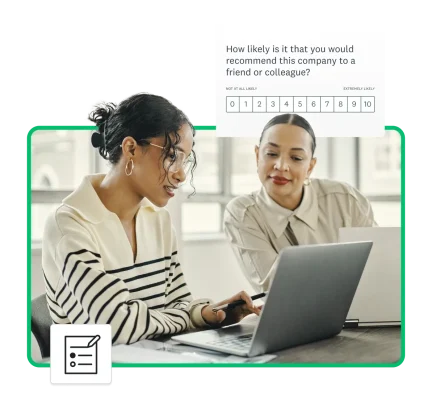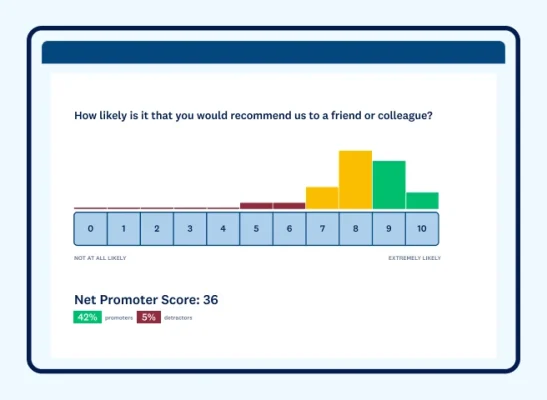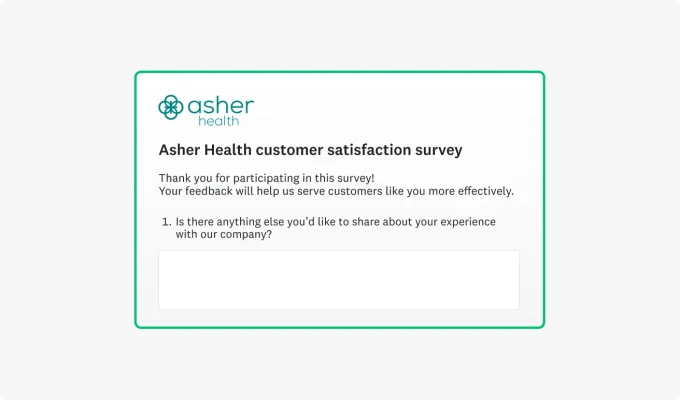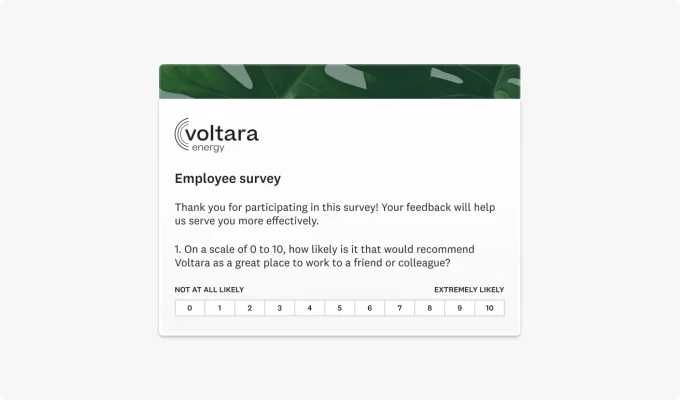50 NPS survey questions for 2025 (examples and templates)
Discover the top 50 NPS survey questions and tactics to improve your customer feedback programme and drive satisfaction.

The Net Promoter Score® (NPS) survey is deceptively simple in that it contains just one question. But behind this single question is a long history, plenty of research and much more information that you should know in order to use it effectively.
In this guide, we’ll cover everything you need to know about NPS survey questions, including 50+ examples and tips for getting started.
NPS survey questions: What is the NPS?

The NPS is a widely used metric that measures customer loyalty. It helps businesses assess overall customer sentiment and predict future growth.
The NPS is a vital tool for customer relationship management, providing:
- A clear measure of customer loyalty, helping businesses assess and track satisfaction over time.
- Insights into customer sentiment, categorising respondents as promoters, passives or detractors.
- Predictions for retention and growth, as higher NPS indicates long-term customer commitment.
- Opportunities for improvement, leveraging feedback from detractors to enhance products and services.
- Competitive benchmarking, allowing businesses to compare performance against industry standards.
- Strategic direction for customer experience, ensuring that efforts align with customer expectations and needs
What is the NPS survey structure?
The NPS survey structure consists of the basic NPS question: “How likely is it that you would recommend a company, product or service to a friend or colleague?”, with an answer scale of 0 to 10. Some surveys also include an open-ended follow-up question to gather qualitative feedback about the rating.
50 NPS survey question examples to ask in 2025
Example of the main NPS question
- “On a scale from 0 to 10, how likely is it that you would recommend [Company/Product/Service] to a friend or colleague?”
Get started with our easy-to-use NPS Survey Template, used by SurveyMonkey customers 147,000+ times.
Examples of NPS follow-up questions

Open-ended general follow-up:
- What is the primary reason for your score?
- What could we do to improve your experience?
- What’s one thing we could change to make your experience better?
- What feature or service would make you more likely to recommend our [Company/Product/Service]?
Follow-ups for promoters (scores of 9–10):
- What do you love most about our product/service?
- What made you give us this score?
- Would you be willing to provide a testimonial or review?
- Would you be interested in joining a customer advocacy programme (e.g. case study, testimonial, referral programme)?
Follow-ups for passives (scores of 7–8):
- What would make you rate us higher?
- What is one thing we could improve to meet your needs more effectively?
- What is one feature or improvement that would make you rate us higher?
- If you could change one thing about our product/service, what would it be?
Follow-ups for detractors (scores of 0–6):
- What was missing or disappointing in your experience?
- How can we make things right for you?
- What could we have done to improve your experience?
- What specific issues led to your rating and how can we address them?
- What changes or improvements would make you more likely to recommend our product/service?
Examples of customer-specific NPS questions
- How likely is it that you will continue to use our product/service over the next year?
- How likely is it that you would recommend our product/service to someone with similar needs?
- How likely is it that you will continue to recommend our product/service to others in the future?
Examples of customer service NPS questions
- How likely is it that you would recommend our self-service support options?
- How likely is it that you would recommend our live chat support to others?
- How likely is it that you would recommend our customer support to a friend or colleague?
Examples of post-purchase NPS questions
- Based on your recent purchase, how likely is it that you would recommend us to a friend or colleague?
- Based on your recent interaction, how likely is it that you would recommend us to a friend or colleague?
Examples of industry-specific NPS questions
SaaS and technology
- How likely is it that you would recommend our software based on its ease of use?
- How likely is it that you would recommend our platform based on the support that you’ve received?
- How likely is it that you would recommend our software based on its integration with the other tools that you use?
Get started: Measure and improve user satisfaction with our Software and App Customer Feedback NPS Survey Template.
E-commerce and retail
- How likely is it that you would recommend us based on your recent purchase experience?
- How likely is it that you would recommend our store based on the delivery and returns experience?
- How likely is it that you would recommend our store based on the value for money of our products?
Get started: Uncover purchase satisfaction with our easy-to-use Post-Purchase Satisfaction Survey Template.
Hospitality
- How likely is it that you would recommend our hotel based on your recent stay?
- How likely is it that you would recommend our hotel based on the friendliness of our staff?
- How likely is it that you would recommend our airline based on your most recent flight?
Healthcare
- How likely is it that you would recommend our clinic based on the quality of care that you received?
- How likely is it that you would recommend our healthcare facility based on its appointment booking process?
- How likely is it that you would recommend our pharmacy based on its convenience and quality of service?
Get started: Discover how to improve the patient experience with our Patient Satisfaction Survey Template.
Telecommunications
- How likely is it that you would recommend our internet service based on connection stability?
- How likely is it that you would recommend our customer support based on your recent interaction?
Automotive
- How likely is it that you would recommend our service centre based on the quality of its repairs?
- How likely is it that you would recommend our vehicle based on its overall reliability?
Financial services
- How likely is it that you would recommend our investment services based on the ease of portfolio management?
- How likely is it that you would recommend our loan services?
Employee NPS questions (eNPS)
- On a scale from 0 to 10, how likely is it that you would recommend [Company] as a great place to work?
- How likely is it that you would recommend [Company] based on career growth opportunities?
- How likely is it that you would recommend [Company] based on leadership and workplace culture?
Related: Explore employee feedback survey templates designed to increase worker happiness and productivity across your organisation.
Follow-up eNPS Questions:
- What do you enjoy most about working here?
- What’s one thing that could improve your experience at work?
- Do you feel supported in your role? Why or why not?
Related: Learn more about leveraging eNPS to improve employee engagement or launch an eNPS survey in minutes with our eNPS Survey Template.
NPS surveys are a powerful way to gauge loyalty and satisfaction, but not all NPS surveys serve the same purpose. There are three primary types of NPS surveys, with each designed to measure customer or employee sentiment in different contexts.
1. Transactional NPS (tNPS)
Transactional NPS surveys are triggered after a specific interaction or event, such as:
- A customer service call
- A product purchase
- An onboarding experience
tNPS surveys help businesses identify strengths and weaknesses at key customer touchpoints. Since tNPS surveys capture feedback in real time, they are useful for making quick improvements to customer interactions.
Transactional NPS example
If customers report a confusing checkout process, the company can quickly simplify it by reducing form fields or adding a progress indicator. By tailoring NPS survey questions to specific stages and interactions in the customer journey, businesses can gather targeted insights that will reveal how to enhance customer satisfaction, loyalty and overall experience.
2. Relational NPS (rNPS)
Relational NPS surveys assess overall customer loyalty and perception of a brand over time. Rather than focusing on a single transaction, rNPS surveys ask customers how likely it is that they would recommend a company based on their entire experience. Businesses typically send rNPS surveys at regular intervals, such as quarterly or annually, to track trends in customer loyalty.
Relational NPS example
A subscription-based software company might send an rNPS survey every six months to gauge customer satisfaction with the platform, customer support and overall value. If scores start to decline, the company can investigate whether issues such as product usability, pricing or support response times are affecting customer loyalty.
Related: Learn the difference between relational and transactional NPS and when to use each.
3. Employee NPS (eNPS)

eNPS measures how likely it is that employees would recommend their company as a great place to work. A strong eNPS indicates high employee satisfaction and engagement, while a low score may signal issues with company culture, leadership or workplace conditions.
Employee NPS example
If employees in a company’s annual eNPS survey give low scores due to a poor work-life balance, leadership can take action by adjusting workloads, offering flexible work arrangements or improving internal communication.
Related: Discover the 20 best eNPS survey questions to ask your workforce and how woom achieved a 46 global eNPS.
NPS question wording best practices (5 tips for success)
The wording of the Net Promoter Score question plays a crucial role in ensuring the validity and reliability of responses. A well-crafted question helps to eliminate bias, maintains consistency and captures genuine customer sentiment. Below are five best practices for formulating effective NPS questions.
1. Use clear, neutral and concise wording
The NPS question should be straightforward, avoiding unnecessary complexity or ambiguity. Clarity ensures that all respondents interpret the question in the same way, leading to more reliable results.
Best practice:
- “On a scale from 0 to 10, how likely is it that you would recommend [company/product] to a friend or colleague?”
What to avoid:
- Biased and exaggerated questions: “Would you strongly recommend our amazing product to everyone you know?”
- Combining two questions: “How satisfied are you with our product and would you recommend it?”
Pro-tip: Leverage customisable survey templates, such as our Net Promoter Score survey templates, to enhance the quality of the insights you gather from different customer segments.
2. Avoid leading questions
Leading questions subtly push respondents towards a particular answer, compromising the integrity of the results. Keeping the wording neutral prevents respondents from feeling obligated to answer in a certain way.
What to avoid:
- Since our product is highly rated, would you recommend it to others?
- How much did you enjoy our seamless checkout process?
- How much do you love our amazing new brand design?
3. Use the word ‘recommend’
The word ‘recommend’ is a crucial aspect of the NPS question as it specifically measures customer loyalty. When you ask about recommending a product, you’re asking whether a customer would actively endorse your product or service to others, which is a key indicator of satisfaction and brand loyalty. Other verbs, such as ‘share’ or ‘suggest’, can soften the commitment and lead to weaker customer sentiment.
4. Avoid emotionally charged wording
Phrasing that includes emotional or overly enthusiastic language can bias respondents’ answers. Words such as ‘amazing’, ‘love’ or ‘incredible’ might make customers feel pressured to rate more highly, even if their experience wasn’t truly exceptional.
For example:
- “How much do you love our product and recommend it to others?”
5. Use consistent rating scales
Consistency is key when it comes to NPS surveys. You should use the standard 0–10 scale to maintain consistency in terms of how data is collected, analysed and compared. Deviating from the standard scale can introduce discrepancies in responses and make it harder to interpret data across different surveys. Stick to the 0–10 scale for comparability and easier data analysis.
How many questions should an NPS survey have? (Hint: keep it short)
How long should NPS surveys be? Wendy Smith, senior manager, research science at SurveyMonkey, says:
- “We recommend keeping NPS surveys on the shorter side. Surveys that ask too many questions can lead to lower response rates and incomplete answers. The longer the survey, the higher the chances are that respondents will abandon it halfway through.”
The single, most important NPS question
At the heart of every NPS survey is the core question:
- “On a scale from 0 to 10, how likely is it that you would recommend [company/product/service] to a friend or colleague?”
This question serves as the foundation for calculating your NPS and gauging customer loyalty. It is the one question that matters most and should always be included in the survey.
Follow-up questions (one to two is optimal)
While the NPS question provides a strong indication of customer loyalty, follow-up questions help clarify why respondents rated you the way they did. Limiting follow-up questions to one to two ensures that you’ll gain valuable insights without overwhelming the respondent. For example:
- “What is the primary reason for your score?” (open-ended)
- “What can we do to improve your experience?” (open-ended or multiple choice)
Demographic NPS questions
Consider adding a few demographic questions to add further context to your NPS results. These questions can help you to segment responses and uncover insights according to customer profile.
Common demographic questions include:
- “What is your age group?”
- “Which region are you located in?”
- “What is your role/industry?”
How to analyse NPS survey responses
Analysing NPS survey responses helps businesses understand customer sentiment and take action to improve loyalty. By interpreting the scores and feedback, companies can identify strengths, address weaknesses and enhance the overall customer experience.
Step 1: Calculate your score
The NPS is calculated using the formula:
- NPS = % of promoters−% of detractors
Step 2: Group and assess feedback
The key to effective analysis is segmenting responses into:
- Promoters (scores of 9–10): Loyal customers who are likely to recommend your business.
- Passives (scores of 7–8): Satisfied but not enthusiastic customers.
- Detractors (scores of 0–6): Unhappy customers who may spread negative feedback.
Let’s dive into how to analyse promoter, passive and detractor responses.
Promoters (scored 9–10)
Analyse promoters to identify what drives their loyalty: service, product quality or brand values. Look for recurring themes in their feedback and track engagement trends to maximise advocacy. Understanding their referral behaviour and repeat purchases can help to reinforce their satisfaction.
Passives (scored 7–8)
Passives provide insight into areas where expectations are met but not exceeded. Compare their feedback with promoters to pinpoint opportunities for improvement. Track sentiment changes over time to assess whether small enhancements, such as better communication or added features, could increase their loyalty.
Detractors (scored 0–6)
Detractors highlight weaknesses in the customer experience. Look for recurring issues such as pricing, usability or service complaints to prioritise improvements. Segment their feedback to identify patterns and track whether intervention efforts, such as targeted outreach or service recovery, successfully improve their perception.
Related: Discover tips for following up with NPS promoters, passives and detractors to boost customer satisfaction.
Step 3: Identify key trends and themes
Once responses have been segmented, you should analyse open-ended feedback to uncover any recurring themes. Consider grouping feedback into categories such as product quality, customer service, pricing or usability. Using sentiment analysis tools or manual review, identify trends that highlight what drives loyalty and what requires improvement.
Now let’s dive into how to take action regarding NPS survey data.
What to do with feedback from NPS survey data
Collecting NPS survey data is just the first step; it’s what you do with the feedback that truly drives impact. Here are some key ways to analyse and act on NPS responses to improve customer and employee experience.
Segment responses for deeper insights
Break down NPS responses according to demographic data (e.g. age, persona, income), customer lifecycle stage or other key factors to understand trends across different groups. This will help you pinpoint where improvements are needed most.
Pro tip: When implementing NPS strategies, it’s crucial to consider the diversity and size of your customer base to ensure that survey responses are representative of the overall customer population. Learn more about collecting demographic data in surveys.
Identify key themes from open-ended questions
Open-ended feedback provides valuable context. Analysing recurring themes in customer comments can highlight common pain points or positive experiences that influence overall satisfaction.
Act on detractor feedback
Detractors (scores of 0–6) indicate dissatisfaction. Contact these customers to understand their concerns, resolve their issues and prevent churn. Learn tactics to turn NPS detractors into promoters.
Leverage promoter feedback
Promoters (scores of 9–10) are your brand advocates. Encourage them to leave reviews, share testimonials or participate in referral programmes to amplify positive word of mouth.
Engage passive respondents
Passives (scores of 7–8) are neutral but can be influenced. Understanding what would push them towards becoming promoters can help to increase loyalty, whether it’s better pricing, improved features or enhanced service.
Implement targeted improvements
Use NPS feedback to drive specific changes, such as streamlining a frustrating onboarding process or enhancing customer support responsiveness. Small, targeted improvements can significantly boost satisfaction.
Monitor trends over time
Regularly track NPS scores and qualitative feedback to identify shifts in customer sentiment and measure the impact of changes that you’ve made.
Incorporate feedback into strategy
NPS insights should inform broader business decisions, from product development to customer service training, ensuring that improvements align with customer expectations and drive long-term success.
Increase customer satisfaction with our NPS survey template
Tracking and improving customer satisfaction is essential for any business looking to build loyalty and drive growth.
Ready to improve customer satisfaction? Get started with our Net Promoter Score Survey Template, or learn how to launch a successful NPS programme with SurveyMonkey.
NPS survey question FAQs
- What is the importance of NPS in customer satisfaction?
- What does a high NPS score mean?
- What is the history of NPS?
Net Promoter, Net Promoter Score and NPS are trademarks of Satmetrix Systems, Inc., Bain & Company, Inc. and Fred Reichheld.
Discover more resources

Solutions for your role
SurveyMonkey can help you do your job better. Discover how to make a bigger impact with winning strategies, products, experiences and more.

Hornblower enhances global customer experiences
Discover how Hornblower uses SurveyMonkey and powerful AI to make the most of NPS data, collect customer insights and improve customer experiences.

Ultimate customer satisfaction guide: 8 tactics for improvement
What is customer satisfaction? Read our complete guide to discover what customer satisfaction is, how to measure it and eight strategies for business success.

A Guide to the Customer Effort Score (CES): What It Is and How to Use It
Learn how to measure customer satisfaction and experience using the customer effort score (CES). This guide explains what you need to know.